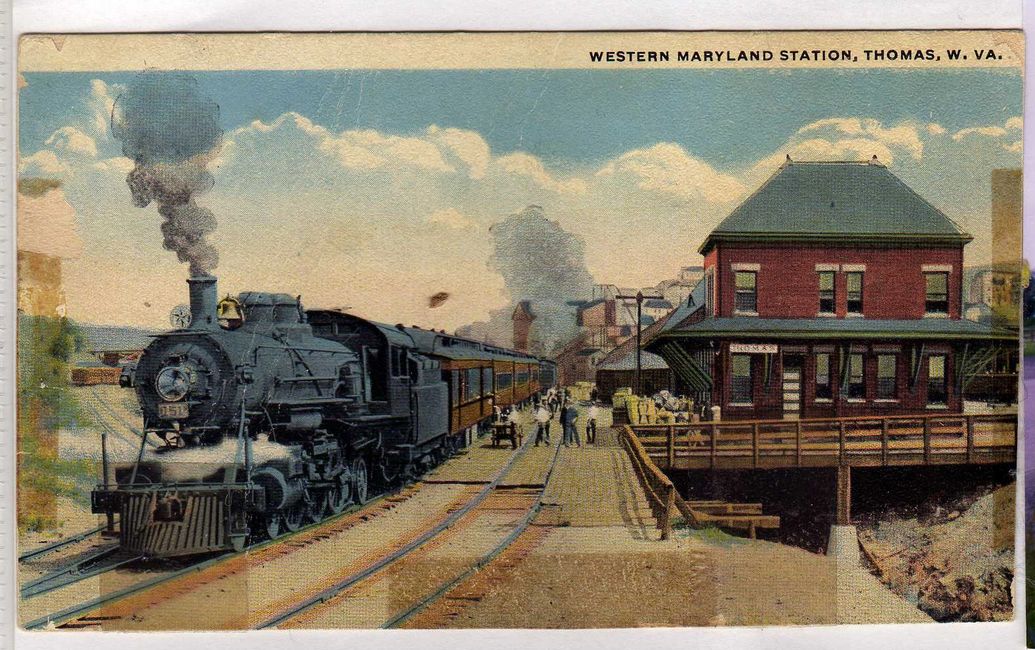
The Railroad - Connecting Thomas to the WOrld
History of the WVC&P
The West Virginia Central and Pittsburg (WVC&P) (Former Railyard, Tour No. 36) was founded by Henry Gassaway Davis, one of the most important figures in West Virginia history. Davis began his career as a brakeman and conductor for the Baltimore and Ohio Railroad, and eventually undertook his own business ventures in railroads, coal and banking. Davis also served in the West Virginia legislature and United States Senate and was the Democratic nominee for Vice President in 1904. His company began building the WVC&P along the North Branch of the Potomac River in 1880 to access the natural resources in Tucker County. On August 10, 1884, the first train rolled into Fairfax, later renamed Thomas after Henry G. Davis’s brother and business partner, Thomas B. Davis.
The WVC&P’s structures around Thomas included a machine shop, roundhouse and freight depot, which are not part of the historic district and are no longer in existence. The brick passenger depot, built in 1900, was accessible only by foot via a wooden overpass and staircase until a road was built in 1925. Though these particular railroad structures no longer exist, the Thomas Commercial Historic District exists due to the railroad and is a continuing testament to its importance. In 1902, the line was sold and became part of the Western Maryland Railway. The railroad transitioned through several mergers, becoming part of the Baltimore and Ohio, Chesapeake and Ohio, and finally CSX. The last train traveled through Thomas in 1983.
An Essential Link
The arrival of the railroad connected Thomas with the world and was responsible for the growth of the Thomas Commercial National Register Historic District. No longer was the area an isolated wilderness, accessible to only the hardiest explorers. People from all over the United States and Europe poured into town to work for the booming coal and timber industries, every one of them arriving by train. Daily trains took residents to Cumberland, Maryland and beyond for shopping and travel. Trains also brought all manner of goods and communication to the Thomas Commercial District– imported food, new home appliances, the latest movies, newspapers, letters from friends and relatives, automobiles ( Milkint’s Garage, Tour No. 33) and even entire houses (residence, Tour No. 36) arrived by boxcar. Molly and Lil Schilansky, two sisters who operated a dress shop on East Avenue (Tour No. 5), frequently traveled to New York City to purchase the latest fashions for their customers. The building materials, including glass storefronts, carved wooden brackets, cornices, pressed tin ceilings and other items to construct almost every building in the historic district were brought by train. Most importantly, however, the railroad was the Davis Coal and Coke Company’s essential link for converting coal to money.
The Western Maryland Depot (above):
This historic postcard depicts the hustle and bustle of the Thomas Depot in its heyday. (Courtesy Joseph Sagace)

Goods including automobiles were imported by train car. This photo captures the transition between train and auto in the 1920s. Milkint’s Garage (Tour No. 33) is seen at the right edge of the photo. (Courtesy Joseph Sagace)

The photo at right shows the Thomas Commercial Historic District and the Western Maryland Railway circa 1905. Tour buildings on East Avenue, left to right: 2-story white building (no longer extant); 37; 38; two 2-story buildings (no longer extant); 1 (Cottrill's Opera House); small wooden building (no longer extant); obscured by engine steam; 4 (prior to expansion); 6; Imperial Hotel (no longer extant).
Buildings on Spruce Street, left to right: 28; 27; four wooden buildings (no longer extant); 25; two 3-story buildings (no longer extant); 24; 22; house (no longer extant); 20. (Courtesy Joseph Sagace)
The Thomas Depot was centrally located between the commercial district, coal mines and company offices. It was destroyed by a tornado in 1944. This 1903 photo (left) shows the wooden footbridge and elevator used to reach the building. (Courtesy Joseph Sagace)

The landscape at right shows the relationship between the railroad freight depot (center), coal company power plant (with smokestacks to the right), and Thomas Commercial Historic District (in background to the left). (Courtesy: Joseph Sagace)
The Thomas Commercial Historic District is oriented parallel to the railroad, demonstrating the important relationship between the two. The photo at left, taken before DePollo’s store (No. 15) was constructed in 1916, shows the following East Avenue buildings on the tour (left to right): 9; 10; no longer extant; 11; no longer extant; 13; 14; three structures no longer extant; and 16. On Spruce Street (right to left) are houses 17 and 18; the 4-story Mountain View Hotel (no longer extant); 2-story building no longer extant; 20; house no longer extant; 22; and 24. (Courtesy Western Maryland Railway Historical Society)
The Thomas train depot was a short walk from the downtown commercial and residential areas. (Courtesy Russell L. Cooper)
The coal-fired steam locomotive powered Thomas for many decades. (Courtesy Western Maryland Railway Historical Society.)
Download the Railroad Industry Thomas Walking Tour Sign
Railroad (pdf)
DownloadHistoric Thomas West Virginia Walking Tour
a Project of the Tucker County Historic Landmark Commission, West Virginia Department of Arts, Culture and History, Aurora Research Associates, LLC and Digital Relativity, Inc.
www.aurora-llc.com Digitalrelativity.com
Copyright © 2020 Historic Thomas West Virginia Walking Tour - All Rights Reserved.
Powered by GoDaddy Website Builder